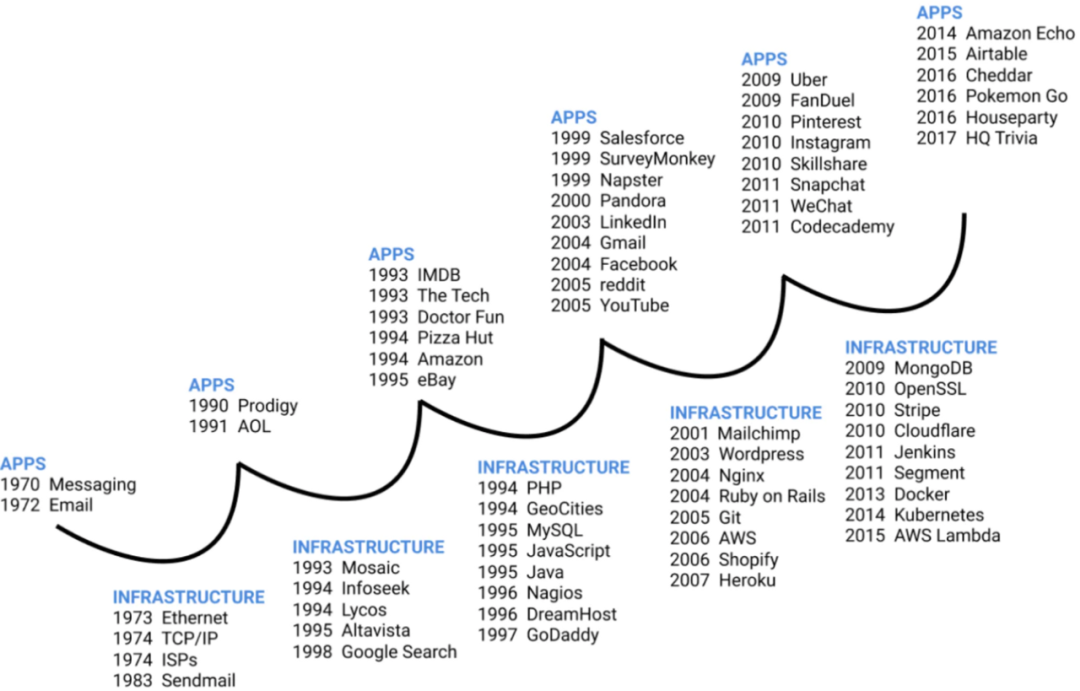Original Text: https://p.mirror.xyz/AqrcAATunMgnPnyxHBYMh1EmzZFKqrtogLPTcTwgwOl
Recently, in my conversations with many practitioners and investors in Web3, I learned that the promotion of Web3 is still hindered by the lack of infrastructure. It is widely believed that we need better wallets, Alt L1s (alternative Layer 1 solutions such as NEAR, Solana, etc.), rollups, Rollups based on Rollup (referring to Base Chain based on OP Stack), multi-chain bridges, Web3-native growth tools, and so on. However, in reality, the biggest problem faced by most infrastructure teams is the lack of enough consumer teams to build excellent downstream applications. Five years ago (!), Dani Grant and Nick Grossman of USV mentioned in their post “The Myth of the Infrastructure Phase”:
In the web3 community, there is a common view that we are currently in the infrastructure phase and we need to build better base chains, better interchain interoperability, better clients, wallets, and browsers. The core idea here is that we need tools that allow us to easily build and use applications running on the blockchain. Once we have these tools, we can start building these applications.
However, in conversations with founders who are building infrastructure, we constantly hear that their biggest challenge is how to attract developers to build applications on these infrastructures.
The prevailing view now is that new computing platforms start with a discrete infrastructure phase and then form an ecosystem of applications. However, in reality, new computing platforms often start with killer applications, which in turn tell us what types of infrastructure we need to build, and then the “Application Infrastructure Cycle” begins.

https://www.usv.com/writing/2018/10/the-myth-of-the-infrastructure-phase/
I believe this framework has explained the subtle relationship between current Web3 consumer products and infrastructure. We need more teams to build at the consumer layer, which will tell us what infrastructure people really need. Undeniably, better access processes and cheaper transaction fees will give birth to new consumer products, but focusing on the present, the infrastructure we have today is already sufficient to create some remarkable products and experiences.
For example, the examples of Reddit Collectibles and Nike .SWOOSH have proven that traditional consumer brands can also create explosive products under the existing facilities. At the same time, SoRare and Immortal Game have achieved some success by combining existing products such as fantasy sports and chess with Web3 elements, offering unique value propositions (ownership of in-game assets).
However, the fact is that in the past few years, the fastest-growing Web3 consumer products have been primarily driven by speculation, including exchanges, NFT markets, wallets, games, and NFT projects. However, this phase has already ended (due to rising interest rates and other macro factors). Speculation is not always a bad thing. In fact, we often need speculators to stimulate interest and investment in new technologies.
However, the future of the Web3 consumer market requires the creation of engaging products and experiences (I know, it’s a radical idea). Over time, most people may not even realize that they are interacting with blockchain or tokens. They may simply refer to Web3 elements as digital collectibles, points, badges, membership cards, or any other consumer-friendly terms.
For example, here are some products and experiences that excite me in the coming years:
- Games where millions of players collect and trade in-game assets as NFTs
- Web3 brands and creators building communities with millions of NFT holders
- Web3 IP spreading through the media and entertainment industry
- Community-driven record labels nurturing the next generation of top artists
- Web2 brands offering fun, novel, and gamified experiences built with NFTs
- Physical products with NFC chips that unlock digital experiences through scanning
New infrastructure will undoubtedly help make these experiences simpler, more scalable, and more cost-effective. However, the future of Web3 depends on teams building consumer products and experiences that are outstanding and loved by the users.
Author: LianGuaitrickRivera
Translation: Zhiwei Bao
Proofreading: EffectChen
Formatting: 小空
Review: Ines
Like what you're reading? Subscribe to our top stories.
We will continue to update Gambling Chain; if you have any questions or suggestions, please contact us!